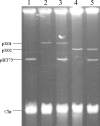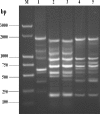Conjugative transfer of insecticidal plasmid pHT73 from Bacillus thuringiensis to B. anthracis and compatibility of this plasmid with pXO1 and pXO2
- PMID: 19948871
- PMCID: PMC2805224
- DOI: 10.1128/AEM.01984-09
Conjugative transfer of insecticidal plasmid pHT73 from Bacillus thuringiensis to B. anthracis and compatibility of this plasmid with pXO1 and pXO2
Abstract
Bacillus anthracis, the etiologic agent of anthrax, is genetically close to and commonly shares a giant gene pool with B. cereus and B. thuringiensis. In view of the human pathogenicity and the long persistence in the environment of B. anthracis, there is growing concern about the effects of genetic exchange with B. anthracis on public health. In this work, we demonstrate that an insecticidal plasmid, pHT73, from B. thuringiensis strain KT0 could be efficiently transferred into two attenuated B. anthracis strains, Ba63002R (pXO1(+) pXO2(-)) and Ba63605R (pXO1(-) pXO2(+)), by conjugation in liquid medium in the laboratory, with transfer rates of 2.3 x 10(-4) and 1.6 x 10(-4) CFU/donor, respectively. The B. anthracis transconjugants containing both pHT73 and pXO1 or pXO2 could produce crystal protein Cry1Ac encoded by plasmid pHT73 and had high toxicity to Helicoverpa armigera larvae. Furthermore, the compatibility and stability of pHT73 with pXO1/pXO2 were demonstrated. The data are informative for further investigation of the safety of B. thuringiensis and closely related strains in food and in the environment.
Figures




Similar articles
-
Involvement of Tn4430 in transfer of Bacillus anthracis plasmids mediated by Bacillus thuringiensis plasmid pXO12.J Bacteriol. 1989 Jan;171(1):104-13. doi: 10.1128/jb.171.1.104-113.1989. J Bacteriol. 1989. PMID: 2536653 Free PMC article.
-
What sets Bacillus anthracis apart from other Bacillus species?Annu Rev Microbiol. 2009;63:451-76. doi: 10.1146/annurev.micro.091208.073255. Annu Rev Microbiol. 2009. PMID: 19514852 Review.
-
Genomic Characterization and Copy Number Variation of Bacillus anthracis Plasmids pXO1 and pXO2 in a Historical Collection of 412 Strains.mSystems. 2018 Aug 14;3(4):e00065-18. doi: 10.1128/mSystems.00065-18. eCollection 2018 Jul-Aug. mSystems. 2018. PMID: 30116789 Free PMC article.
-
Conjugative transfer, stability and expression of a plasmid encoding a cry1Ac gene in Bacillus cereus group strains.FEMS Microbiol Lett. 2004 Feb 9;231(1):45-52. doi: 10.1016/S0378-1097(03)00925-X. FEMS Microbiol Lett. 2004. PMID: 14769465
-
Bacillus anthracis genetics and virulence gene regulation.Curr Top Microbiol Immunol. 2002;271:143-64. doi: 10.1007/978-3-662-05767-4_7. Curr Top Microbiol Immunol. 2002. PMID: 12224521 Review.
Cited by
-
The Bacillus cereus Group: Bacillus Species with Pathogenic Potential.Microbiol Spectr. 2019 May;7(3):10.1128/microbiolspec.gpp3-0032-2018. doi: 10.1128/microbiolspec.GPP3-0032-2018. Microbiol Spectr. 2019. PMID: 31111815 Free PMC article. Review.
-
Genomic, Antimicrobial, and Aphicidal Traits of Bacillus velezensis ATR2, and Its Biocontrol Potential against Ginger Rhizome Rot Disease Caused by Bacillus pumilus.Microorganisms. 2021 Dec 29;10(1):63. doi: 10.3390/microorganisms10010063. Microorganisms. 2021. PMID: 35056513 Free PMC article.
-
The genetic diversity of cereulide biosynthesis gene cluster indicates a composite transposon Tnces in emetic Bacillus weihenstephanensis.BMC Microbiol. 2014 Jun 7;14:149. doi: 10.1186/1471-2180-14-149. BMC Microbiol. 2014. PMID: 24906385 Free PMC article.
-
Conjugation across Bacillus cereus and kin: A review.Front Microbiol. 2022 Nov 4;13:1034440. doi: 10.3389/fmicb.2022.1034440. eCollection 2022. Front Microbiol. 2022. PMID: 36406448 Free PMC article. Review.
References
-
- Andrup, L., L. Smidt, K. Andersen, and L. Boe. 1998. Kinetics of conjugative transfer: a study of the plasmid pXO16 from Bacillus thuringiensis subsp. israelensis. Plasmid 40:30-43. - PubMed
-
- Baumann, L., K. Okamoto, B. M. Unterman, M. J. Lynch, and P. Baumann. 1984. Phenotypic characterization of Bacillus thuringiensis and Bacillus cereus. J. Invertebr. Pathol. 44:329-341.
-
- Dixon, T. C., M. Meselson, J. Guillemin, and P. C. Hanna. 1999. Anthrax. N. Engl. J. Med. 341:815-826. - PubMed
Publication types
MeSH terms
Substances
LinkOut - more resources
Full Text Sources

